|
||||||||||
|
|
||||||||||
|
||||||||||
|
|
||||||||||
Ground effect primarily affects the aerodynamic behavior of a conventional fixed-wing aircraft during landing. In order to understand what ground effect is and how it works, one must first understand the concept of trailing or tip vortices. A vortex is an energetic swirling mass of air or water like a tornado or whirlpool. All aircraft, and birds for that matter, generate vortices off their wingtips. These vortices form because of the difference in pressure that exists between the upper and lower surfaces of the wing.

The Bernoulli theory of lift tells us that a wing creates lift because the air moving over the upper surface of the wing is at a lower pressure than the air beneath the wing. This difference in pressure creates a lift force that pulls the wing upward. Because of this difference in pressure, however, the high pressure air beneath the wing also tries to move outward and around the wingtip to escape to the low pressure region above the wing. As the wingtip flies forward, this motion of air creates a swirling vortex that trails behind. One of these vortices is left aft of each wingtip, swirling in opposite directions, to create a pair of trailing vortices behind the wing.
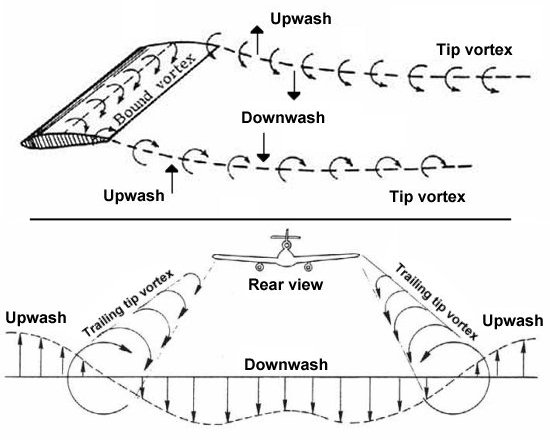
Trailing vortices are undesirable primarily because they increase drag. Drag is the force that opposes an aircraft's forward motion and reduces its efficiency. While vortices do not directly increase the drag of a plane, they create a downwash that deflects the air behind a wing downward. This downwash decreases the lift generated by the wing.

In order to make up for that lost lift, the wing's angle of attack must be increased. Angle of attack defines the angle at which the wing meets the oncoming air stream. Increasing this angle causes the lift generated by a wing to increase. The lift continues to increase until a particular angle of attack called the stall angle is reached. At this critical angle, the air flowing over the wing separates from the wing surface causing the lift to decrease.

Now how does this interaction between downwash and lift cause drag to rise? The catch is that as lift increases with higher angle of attack, drag also increases at a faster rate. Therefore, as a wing's angle of attack is increased to compensate for the lift lost to downwash, the penalty is higher drag that reduces the efficiency of the wing. This form of drag is referred to as induced drag because it is induced by the generation of lift. Induced drag is the dominant type of drag acting on an aircraft at low speed, such as during takeoff and landing. It becomes considerably less significant at high speed during cruise flight where a different type of drag called parasite drag is dominant.
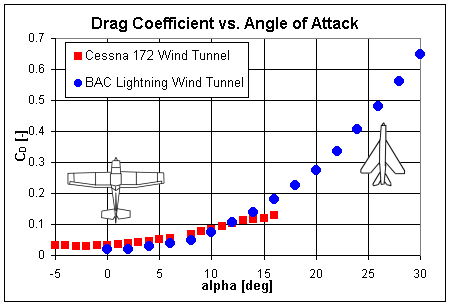
The amount of influence that trailing vortices have on the aerodynamic behavior of a wing depends on a number of factors. One of these is the distance of the wing from the ground. When operating very close to the ground, the vortices can become partially blocked and prevented from fully forming. This disruption of the trailing vortices reduces the magnitude of the downwash they create. A reduction in downwash results in higher lift and lower induced drag for a given angle of attack. As a result, ground effect increases the aerodynamic efficiency of a wing.
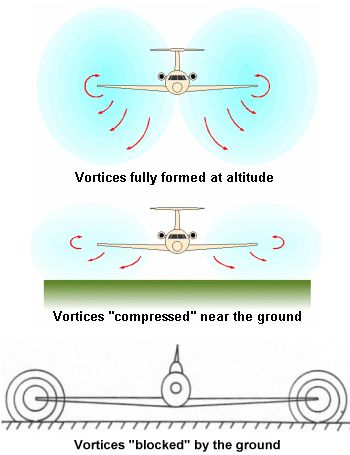
A second factor that influences the impact of trailing vortices on an aircraft is the speed at which it travels. A common misconception about ground effect is that a "bubble" or "cushion" of air forms between the aircraft and ground that somehow prevents the aircraft from landing or even forces the plane upward away from the ground. Furthermore, many believe that the strength of this cushion grows the faster an aircraft flies when near the ground. Both of these beliefs are wrong.
First of all, there is no bubble of air that pushes an aircraft away from the ground. The true cause of ground effect is the influence of the ground on the wing's angle of attack as described above. Ground effect does nothing to force an aircraft upward from the ground, it only changes the relative amount of lift and drag that a wing will generate at a given speed and angle of attack. Second, we have seen that this effect actually decreases with speed since induced drag has increasingly less influence on an aircraft the faster it flies.
This relationship can be better understood by studying the relationship between lift, speed, and angle of attack. As demonstrated in an article describing thin airfoil theory, lift is linearly proportional to angle of attack for angles below the stall angle. However, the lift equation says that lift is also proportional to the square of speed. These two relationships tell us that the faster a wing flies, the lower an angle of attack is required to generate sufficient lift to remain in flight. It is for this reason that an aircraft flying at high speed during cruise operates at a very low angle of attack. The cruise angle of attack for a large airliner like the Boeing 757, for example, is around 1° or 2°. Aircraft fly at a much higher angle of attack during takeoff and landing because it is during these stages of flight when speed is the lowest and a high angle of attack is required to generate the needed lift.
This dependency is rather simple to remember--if speed is high, angle of attack is low. If speed is low, angle of attack must be high. Furthermore, when angle of attack is low, we have seen that induced drag is also low. If induced drag is low, the downwash generated by the wing must be small. If downwash is small, then the trailing vortices must be relatively narrow in diameter. If the trailing vortices are narrow, then the proximity of the ground can have little effect on their formation and ground effect will be minimal by definition.
Given this explanation, it should come as no surprise that pilots most often report the influence of ground effect during a traditional landing. It is during the landing approach when a plane is at its lowest speed and highest angle of attack of any portion of its flight. In addition, the plane's slow speed provides less energy to spin the tip vortices, and the lower a vortex's rate of rotation, the wider in diameter it becomes. This combination of high angle of attack and low speed creates a large downwash and trailing vortices with a large diameter that have a significant influence over a plane's wing. These wide vortices are more likely to be blocked as the plane comes closer to the ground, so any reduction in their strength has a correspondingly significant impact on the aircraft's aerodynamic behavior.
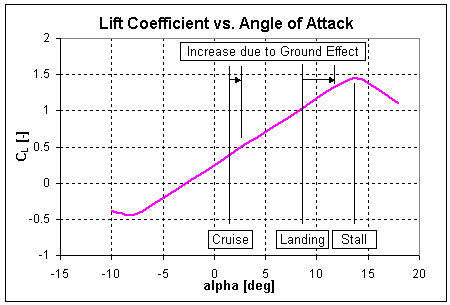
The differences in the relative influence of ground effect on a wing are compared conceptually in the above diagram. This plot illustrates a typical lift curve for an aircraft showing how the lift coefficient varies with angle of attack. The lift coefficient required for cruise flight is rather low since the aircraft's speed is high, so the plane operates at a low angle of attack. The opposite occurs during landing when speed is low and a high lift coefficient is needed, so angle of attack must also be high. The impact of ground effect on a wing operating at a low angle of attack is quite small as indicated by the slight increase in angle of attack created by proximity to the ground. The same does not hold true at high angle of attack where ground effect has a much greater influence.
Nevertheless, we do see that ground effect often does have some small effect on a wing even at low angles. Is it significant enough to somehow force the plane away from the ground or make it difficult, if not impossible, to control? The answer is again no since the pilot can easily reduce a plane's angle of attack to eliminate any excess lift and maintain a desired flight path. This feat is accomplished thanks to devices called control surfaces placed along a plane's wing and tail.
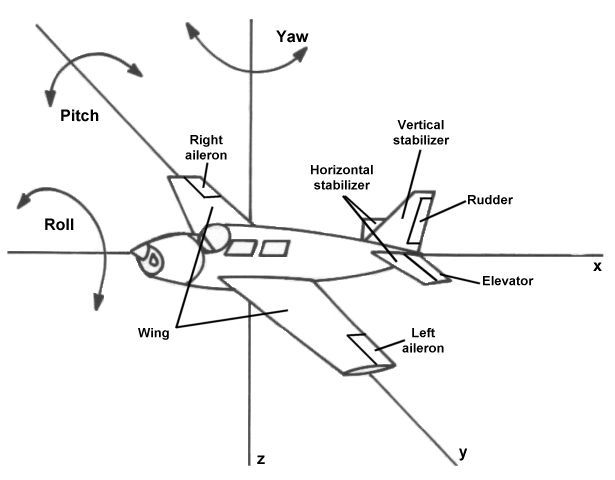
The primary surface used to control the plane's angle of attack is the elevator located on the horizontal stabilizer. Deflecting the elevator up or down causes the nose of the plane to rotate up and down changing its angle of attack. This rotation is called pitch. The ailerons at each wingtip can also be used to influence the angle of attack on each side of the aircraft causing the plane to roll about its centerline. When an aircraft enters ground effect and goes to a higher effective angle of attack, the pilot simply pushes the control yoke forward. This adjustment causes the elevator to deflect downward and pushes the plane's nose downward to reduce its angle of attack. In so doing, the plane's lift is decreased.
That brings us to the question of whether an essentially untrained pilot like terrorist Hani Hanjour could have made these adjustments to fly the Boeing 757 into the Pentagon. While such fine corrections do require some degree of finesse and familiarity with an aircraft's flight characteristics, the level of expertise required is not excessive. We have shown that any influence of ground effect would have been quite small on Flight 77 given its high rate of speed and small angle of attack. The 757 was apparently in a shallow dive as well, further reducing its angle of attack such that any impact of ground effect would have been extremely small.
In addition, many modern airliners are not directly flown by the pilot but by automated systems. Most newer aircraft even use fly-by-wire (FBW) systems that take control inputs from the pilot, process them by computer, and automatically make adjustments to the control surfaces to accomplish the pilot's commands. Though the 757 is not equipped with a fully digital FBW system, it does carry a flight management computer system (FMCS), digital air data computer (DADC), and autopilot flight director system (AFDS) that provide sophisticated control laws to govern the plane's control surfaces. The AFDS not only controls the plane when the autopilot is enabled, but Boeing recommends that these computerized systems always be in operation to advise the pilots on how to best fly the aircraft. The primary advantage of computerized control systems is that they can make corrections to an aircraft's flight path and help prevent the pilot from accidentally putting the plane into an uncontrollable condition. The 757's flight augmentation system is also designed to damp out aerodynamic instabilities, and computerized control systems often automatically account for ground effect by making adjustments to the plane's control surfaces to cancel it out.
These factors make it clear that ground effect could not have prevented a Boeing 757 from striking the Pentagon in the way that Flight 77 did on September 11. Nevertheless, we are still left with the claim that the pilot Hanjour flew a suspiciously "perfect" flight path on his approach to the Pentagon despite his lack of skill. It is unclear what has prompted this belief since very few eyewitnesses even describe how well the aircraft flew. The majority instead focus on the impact and aftermath. Even so, those few who did make statements regarding pilot ability indicate that Hanjour flew in a somewhat erratic manner as one would expect.
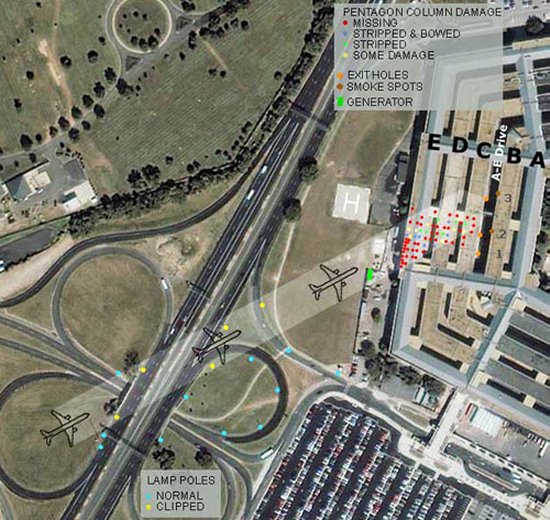
One of the most interesting quotes comes from Afework Hagos who commented on the plane see-sawing back and forth, suggesting that the pilot was struggling to keep the plane level in either pitch or roll or perhaps both. Hagos was stuck in traffic near the Pentagon when the 757 passed overhead. He reported, "There was a huge screaming noise and I got out of the car as the plane came over. It was tilting its wings up and down like it was trying to balance." Another eyewitness named Penny Elgas also referred to the plane rocking back and forth while Albert Hemphill commented that, "He was slightly left wing down as he appeared in my line of sight, as if he'd just 'jinked' to avoid something." These observations were further confirmed by Mary Ann Owens, James Ryan, and David Marra who described the plane's wings as "wobbly" when it "rolled left and then rolled right" and the pilot "tilted his wings, this way and in this way."
This question of whether an amateur could have flown Flight 77 into the Pentagon was also posed to a colleague who previously worked on flight control software for Boeing airliners. Brian F. (he asked that his last name be withheld) explained, "The flight control system used on a 757 can certainly overcome any ground effect. ... That piece of software is intended to be used during low speed landings. A high speed dash at low altitude like [Flight 77] made at the Pentagon is definitely not recommended procedure ... and I don't think it's something anyone specifically designs into the software for any commercial aircraft I can think of. But the flight code is designed to be robust and keep the plane as safe as possible even in unexpected conditions like that. I'm sure the software could handle that kind of flight pattern so long as the pilot had at least basic flight training skills and didn't overcompensate too much."
Brian also consulted with a pair of commercial airline pilots who decided to try this kind of approach in a flight training simulator. Although the pilots were not sure the simulator models such scenarios with complete accuracy, they reported no significant difficulties in flying a 757 within an altitude of tens of feet at speeds between 350 and 550 mph (565 to 885 km/h) across smooth terrain. The only issue they encountered was constant warnings from the simulator about flying too fast and too low. These warnings were expected since the manufacturer does not recommend and FAA regulations prohibit flying a commercial aircraft the way Flight 77 was flown. These restrictions do not mean it is impossible for a plane to fly at those conditions but that it is extremely hazardous to do so, and safety was obviously not a concern to the terrorists on September 11. An aircraft flying at those high speeds at low altitude would also likely experience shaking due to the loads acting on it, but commercial aircraft are designed with at least a 50% safety margin to survive such extremes.
One of the pilots summarized his experiences by stating, "This whole ground effect argument is ridiculous. People
need to realize that crashing a plane into a building as massive as the Pentagon is remarkably easy and takes no
skill at all. Landing one on a runway safely even under the best conditions? Now that's the hard part!"
While he may have been exaggerating a bit for effect, he does raise a valid point that flying skillfully and safely
is much more difficult than flying as recklessly as the terrorists did on September 11.
- answer by Jeff Scott, 21 May 2006
Related Topics:
Read More Articles:


|
Aircraft | Design | Ask Us | Shop | Search |

|
|
| About Us | Contact Us | Copyright © 1997- | |||
|
|
|||